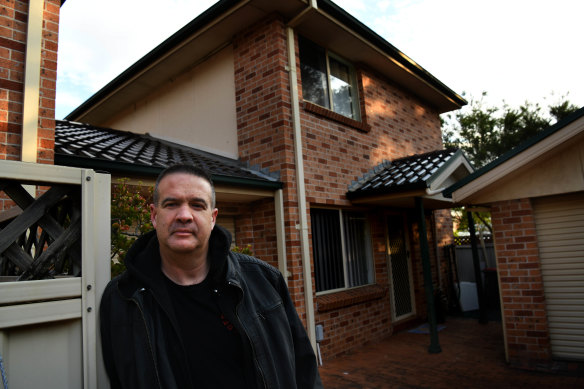‘You can’t cut back on everything’: Home owners almost at breaking point
Save articles for later
Add articles to your saved list and come back to them any time.
Key points
- Repayments for home borrowers have eroded buffers that they were stress tested by the banks.
- It leaves many paying thousands of dollars extra month on mortgage repayments.
- Some households are resorting to second jobs and renting out bedrooms after cutting back on spending in the past year.
Property listings
Home owner Dean Cully has little left to cut from his household budget to keep up with his rapidly rising mortgage repayments, after they jumped more than $1000 per month thanks to the fastest interest rate hikes in a generation.
The 49-year-old factory manager bought a home in western Sydney in April 2022, never imagining a dozen rate hikes would follow in little more than a year.
Dean Cully expected that interest rates would not rise until 2024 but is now experiencing the greatest rate hike in a generation.Credit: Dean Sewell
“Within the first six weeks of me buying a place, the mortgage went up. I started paying off about $2000 a month, and now I’m paying more than $3000. It’s the biggest mortgage I’ve ever had,” Cully said.
Cully, who purchased the Quakers Hill home for he and his daughter, is relying on one wage, so finding an extra $1000 per month has not been easy.
He barely spends any money on non-discretionary items, having already cut back on dining out, entertainment, his gym membership, phone and internet plans and streaming services.
The Reserve Bank’s decision on Tuesday to lift the cash rate another 25 basis points to an 11-year-high of 4.10 per cent, has left him considering a second job to cover his rising costs.
“At the moment there is just no fat, there’s no money to go do anything, there’s no money to go out, to fix anything that needs to be fixed,” Cully said. “I’m toying with getting a second job as with the economy slowing down, I can’t see wages changing.”
He is not alone. Many recent buyers are having budgets stretched more than expected, as rapid rate hikes have surpassed the mortgage serviceability buffers used to stress test their loans for if rates climbed.
Monthly repayments for a homeowner on an average income of $94,000, who borrowed to their maximum capacity of $524,000 in May 2021, has already increased by $1124, Canstar modelling shows.
That outstrips the $775 monthly increase they were stress tested for, assuming rates climbed 2.5 percentage points, leaving the homeowner struggling to find an extra $350 more per month.
‘You wouldn’t be approved for that loan today.’
A homeowner who borrowed $1 million, has already had repayments increase by more than $2000, surpassing their buffer rate by $665 per month.
Even a homeowner who purchased the following year, when the serviceability buffer had lifted to 3 percentage points, is paying $235 per month than what they were stress tested at.
These households would have to find hundreds more to cover repayments after the latest rate hike.
It comes as new Roy Morgan research shows an estimated 1.38 million borrowers, or 27.8 per cent, were at risk of mortgage stress in the three months to April, the highest number since the global financial crisis.
Commonwealth Bank’s head of Australian economics Gareth Aird said there would be little left for some homeowners to cut back on after a year of rate hikes, and warned some households would be at their tipping point.
“You can’t cut back on everything … you’ve got to live. The serviceability [buffer] was just too low given how much the RBA ended up hiking [rates],” Aird said.
“For the more recent entrants, the more you push up rates, the more people … will be forced to sell. Some people will look for additional work, some people will look what else to cut back on, people will look to rent an additional room.”
Westpac senior economist Matthew Hassan said the impact of the rate rises was beginning to snowball.
“Some of the pressure … across the mortgage belt is starting to appear,” he said. “The risks out there are starting to accelerate … because the roll-off of [lower] fixed rates accelerates in the second quarter,” Hassan said.
“Those who borrowed [close to the market peak] are near their limits and are struggling with the rate cycle. It has outstripped their buffer assessment, so that is most definitely where the pain is the hardest.”
Canstar group executive Steve Mickenbecker said more homeowners would be under housing stress with every rate rise.
“A lot of people did borrow up to their maximum to stretch themselves to get in,” Mickenbecker said.
‘It’s a double whammy of the interest rate increase and cost of living increase that has made it super difficult for everybody.’
“Now you add an extra $1000 a month to your repayments on a $500,000 loan and … you’re way over the normal serviceability for a loan. You wouldn’t be approved for that loan today, but you’re into mortgage stress as well,” he said.
Mickenbecker said mortgage stress would hit recent borrowers and first home buyers hardest as they had very little chance of building up savings or making extra repayments before rate hikes began.
“It is very concerning, it hurts people so unevenly.”
Two Red Shoes founder and mortgage broker Rebecca Jarrett-Dalton said many borrowers were feeling the heat as variable rates exceeded what they had been stress tested at.
Reserve Bank governor Philip Lowe.Credit: Bloomberg
“At the beginning of 2020 the buffer was only 2.5 per cent. We’re nearly a whole per cent over their buffer. Everybody’s feeling it, but you’re not necessarily at your limit. But those who had to stretch themselves would be feeling it,” Jarret-Dalton said.
“It’s a double whammy of the interest rate increase and cost of living increase that has made it super difficult for everybody.”
Expert tips on how to save, invest and make the most of your money delivered to your inbox every Sunday. Sign up here for our Real Money newsletter.
Most Viewed in Property
Source: Read Full Article

